



|
Arnor: The North Kingdom of the Dúnedain, Arnor was founded in the year
3320 of the Second Age, after the Downfall of Númenor. Its founder
was Elendil, who was the High King of both Arnor and Gondor (founded
by his two sons, Isildur and Anárion). The tenth King of Arnor,
Eärendur, split the realm between his three sons, so it was later
called Arthedain, Cardolan, and Rhudaur. In Cardolan and Rhudaur,
the Dúnedain soon dwindled enough that by 1350 of the Third Age,
it was overtly allied with Angmar, the realm of the Witch-King.
After the destruction of Angmar, the line of Arnor's Kings never
failed, though Arnor was ruined, and the Kings were called Chieftains
instead. It was from this line that the Kings of Gondor eventually
came from too, with the end of the Third Age and Aragorn's crowning.
|
|
Arthedain: When Eärendur, the last king of Arnor died in the year 861 of the Third Age, the country was split into three separate kingdoms: Arthedain, Cardolan and Rhudar. Arthedain, which contained the former capital city of Annúminas was given into the rule of Amlaith, the eldest of Eärendur's three sons. It was through this kingdom that the line of Isildur was maintained, as the line of Arthedain's kings outlasted those of Rhudar and Cardolan. The borders of Arthedain extended from the Lhun and the Brandywine, and as far east as Weathertop and contained the two palantiri belonging to the Men of the North. One of the Palantiri was located at Amon Sûl. The capital city of Arthedain was at Fornost. In the year 1349 of the Third Age, after the end of the royal lines
in Rhudar and Cardolan, Argleb I claimed kingship over all of the lands
that originally made up the realm of Arnor. However, that claim was contested,
leading to war, which led to the end of all three regions as formal kingdoms.
After this, the royal family of Arthedain continued in secret as the Chieftains
of the Rangers of the North. |
|
|
Annúminas: The first capital of Arnor, Annúminas, was deserted when the capital
city removed to Fornost. Annúminas was rebuilt during the reign
of King Elessar during the Fourth Age.
|
|
|
Angmar: The realm of the Witch-king, later discovered to be the chief
of the Nazgûl. It lasted for approximately 700 years.
Angmar was the enemy of the northern kingdom of Arnor. |
|
|
Angband: Melkor's stronghold, built after he destroyed the two lamps it
was built under the Ered Engryn. Though it was partially destroyed
when the Valar captured Melkor, it was not completely cleaned out
and Balrogs and others still hid there during his captivity. After
he escaped from Valinor, Melkor rebuilt it and it was never again
taken until the Great Battle that ended the First Age of the Sun.
Angband was, of course, destroyed when the most part of Beleriand
sank beneath the ocean.
|
|
|
Aman: The Blessed Realm, and the home of the Valar after Melkor destroyed
Almaren. When Eru changed the shape of the World during the Downfall
of Númenor, Aman was removed from the circles of the World, in such
a way that only the ships of the Elves, could return by the Straight
Road. Aman had many names of which the most common were, The Blessed
Realm and the Undying Lands.
|
|
|
Arda: Our World. |
|
|
Archet: A village in the Bree-land where Hobbits and Men live together.
Archet is located to the north of the Chetwood.
|
|
|
Amon Anwar (The Hill of Awe): The hill within the Firien Wood, later used as a beacon in , the
line of beacons between Gondor and Rohan. Prior to the coming of
Cirion, Amon Anwar was the site of the tomb of Elendil. Isildur
set it there as being the center of the Realm of Gondor as it was
at that time. Being a holy place it was chosen for the oath of Cirion
and Eorl. After that time, Elendil's tomb was removed to the Hallows
in Minas Anor, seeing as the hill was no longer the center of the
realm, but on it's border. After that the hill became one of a line
of beacons, and being on the border, its upkeep was by both men
of Gondor and of Rohan, though later the upkeep fell to Rohan.
|
|
|
Also called the Great River, clearly this is one of the largest, if not the largest, river in the north-western part of Middle-Earth in the Third Age. It started in the Grey Mountains and roughly paralleled the Misty Mountains on the eastern side. At one point in history, hobbits lived on the banks of the river, though they later migrated North and West. Only three permanent crossings are described. The first is the Carrock, near the High Pass. It is a ford with a rock in the middle. The second is called the Old Ford, fairly close to the Carrock. The third was destroyed by the time of the War of the Ring. It was the bridge in Osgiliath. The only other method of crossing was by swiming (as attempted by Isildur) or by boat. The river passed by or through the realms of Gondor, Rohan, Lothlórien and the region of Rhovanion. Landmarks along it's course included the Gates of Argonath, Tol Brandir, and Rauros. For many years, from the Battle of the Gladden Fields, when Isildur was slain, the River hid the One Ring. It was several centuries later that the Ring was found by two hobbits, Déagol and Sméagol. During the War of the Ring, when the Company was passing down the
River, the Eastern side of the lower Anduin was dangerous because
it was patrolled by Orcs. The western bank however, was still believed
to be safe, although this was disproved when the Company was attacked
at Parth Galen.
|
|
|
Also called simply the Argonath and the Pillars of the Kings. Early in the Third Age, the cliffs on each side of the Anduin River at a narrow point were carved into giant figures of Isildur and Anárion. Each of the figures had it's left hand raised in a warning gesture. In the right hands was an axe, and on the heads was a combination of helm and crown. Beyond the figures, the river widens again. This was where the lawn
of Parth Galen and the hills of Amon Hen and Amon Lhaw were to be
found.
|
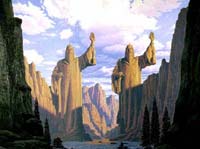 |
Amon Sul: The southernmost hill in the chain of the Weather Hills. The Road skirts along the edge of the hill. In the time of Elendil, there was a tower on the hill. The ruins were still there at the end of the Third Age of the Sun, when Frodo and the others were atacked by the Nazgûl. By that time, the place was known as Weathertop. The location was perfect as a look-out point, as from the top of the hill a person could see for leagues around. |
|
| Back To The Top | |
|
Bree: At the crossing of the North Road and the East Road, Bree is one
of four villages where the Big Folk and the Little Folk live in
harmony. All of the villages are in the Bree-land: Archet, Combe,
Bree and Staddle. The Bree-land was the nearest location settled
by Men to the Shire. The Bree-land was settled by Men first before
the founding of Arnor. Hobbits entered later, around 1300 of the
Third Age.
|
|
Bag-End: The home of Bilbo and Frodo Baggins during the Third Age of the Sun, Bag-End was located in Hobbiton. It was excavated by Bungo Baggins as a home for himself and his wife, Belladonna Took. Bag-End has been described as "the most luxurious hobbit-hole...either under The Hill or over The Hill or across The Water"(H.14-15). After the War of the Ring, Sam and his family lived there as well. Frodo gave Bag-End to Sam when he went into the West. When Frodo left the Shire, he sold it, along with most of its furnishings to Lobelia Sackville-Baggins. For some months after the War of the Ring, Saruman made his home in Bag-End. Bag-End was believed by much of the Shire to be the location of
hidden gold after the return of Bilbo Baggins. Certainly it was home
to one of the richest hobbits in the Shire.
|
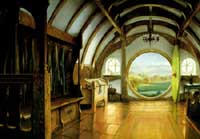 |
|
The Barrow-Downs: The Barrow-Downs were green downs within which there were barrows
predating the arrival of the Dúnedain. In the year 1409, the remaining
Dúnedain of Cardolan took refuge in the Barrow-downs during the
wars with Angmar. Around 1636 of the Third Age, the Barrow-Downs
were inhabited by the Barrow-Wights. After this the Barrow-Downs
became a place of great terror. In Sindarin the Barrow-Downs were
called Tyrn Gorthad.
|
|
|
Barad-Dûr: The tower and dungeons of Sauron in Mordor. Baradur was rebuilt
with the power of the One Ring after the year 1000 of the Second
Age. When Sauron was vanquished by the Last Alliance, Barad-Dûr
was destroyed, though the foundations remained as the One Ring
was intact. It was rebuilt by Sauron and finally destroyed in
the year 3019 with the destruction of the One Ring.
It was said by Gandalf that "those who pass the gates of Barad-Dûr
do not return". (LOTR.313) |
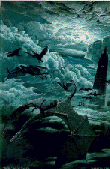 |
The Brandywine River: Called the Baranduin in Sindarin, at one time the Brandywine River
was the eastern border of the Shire. By the time of the War of the
Ring, it was the border between the Eastfarthing and Buckland.
|
|
|
Beleriand: The northwestern portion of Middle-Earth throughout the Ages of
the Stars and the First Age of the Sun, Beleriand was made up of
several regions including Hithlum, Doriath, and Nevrast. In the
north of Beleriand, was Uttumno and Thangorodrim where lived Morgoth.
The focus of The Silmarillion, most probably written by Bilbo Baggins,
was in Beleriand, as were most of the battles and wars making up
the struggle to regain the Silmarils. Beleriand was destroyed and
sank beneath the waves at the end of the First Age of the Sun, during
the struggle between the Valar and Morgoth. The only parts of Beleriand
to survive, apart from some islands made up of mountaintops were
Lindon and some parts of the Blue Mountains, the Ered Luin.
|
|
Brandy Hall: Located in Buckland, Brandy Hall was the chief residence of the Brandybuck family. Excavation of the smial was begun in about the year 2340 by Gorenhad Oldbuck. By the time of the War of the Ring, Brandy Hall had grown to fill the entirety of Buck Hill. Frodo noted in the Red Book that it had "three large front doors, many side doors, and about a hundred windows" (LOTR.112). |
|
Buckland: Buckland is the eastern-most region of the Shire, located between the far side of the Brandywine River and the Old Forest. This is the home of the Brandybuck Family, the head of the family taking the title of Master of Buckland and acting as the regional leader. Settled in the year 2340 of the Third Age, or the year 740 according to the
Shire Reckoning, by Gorenhad Oldbuck, Buckland was outside the official borders
of the Shire until the King Elessar made it an official part of the Shire in
the year 42 of the Fourth Age. |
|
| Back To The Top | |
|
Cair Andros: An island fortress north of Minas Tirith, belonging to Gondor,
Cair Andros is shaped like a ship facing upstream. The name means
Ship of Long Foam.
|
|
|
Caras Galadhon: The chief city in Lothlórien.
|
|
|
Cirith Ungol: The Spider Pass, near to Minas Morgul on the borders of Mordor.
Cirith Ungol was the route chosen by Frodo, on the advice of Gollum,
to enter Mordor. It was a high, narrow pass overlooked by a fortress
at the top. As an added safeguard, there lived Shelob, the greatest
of the giant spiders remaining in Middle-Earth. The route through
Cirith Ungol, included two very long stairways and a branching orc
tunnel where Shelob lived.
|
|
|
Carn Dûm: A fortress and city of the realm of Angmar. The only
recorded mention of the city is after the Hobbits escaped
from the Barrow-Wight.
|
|
Cardolan: One of the three regions that Arnor was broken into in the year 861 of the Third Age of the Sun. The other two were Arthedain and Rhudar. The Dúnedain of Cardolan fought the forces of the Witch-King of Angmar until they were forced to flee to the Old Forest and the Barrow-Downs in the year 1409. They were able to return soon after and the Dúnedain inhabited the country again until the Great Plague of 1636. After that the region was no longer considered to be a country. However, there were still settlements in existence until the War of the Ring and perhaps after. Cardolan was the region between the Baranduin and the Gwathlo-Mitheithel
and south of the East Road. |
|
Crickhollow: The cottage that Frodo Baggins bought in Buckland after he sold Bag-End as a part of his plan to leave the Shire. Who he bought the house from is not said. Frodo only stayed there overnight the one night, before leaving again. A few days after the four hobbits left, the Black Riders discovered thre place and broke down the door. Crickhollow is not mentioned again until after the War of the Ring,
when it was named as the place that Meriadoc Brandybuck and Peregrin Took
lived. |
|
Combe: One of the villages which made up the Bree-Land, Combe was apparently
a little further away than the others. Combe is described as having been
located in a deep valley somewhat to the east. As with the rest of the
Bree-Land, the village of Combe was inhabited by a population formed of
both Hobbits and Men. |
|
| Back To The Top | |
|
The Dagorlad: The Battle-plain. The Dagorlad was in front of the Black Gate and
bordered on at least one side by the Dead Marshes, which had been
creeping over the edges. At least two battles have been fought on
the Dagorlad, before the War of the Ring: that of the Last Alliance
in the year 3434 of the Second Age, and at least one battle with
the Wainriders.
|
|
|
The Dead Marshes: The Dead Marshes are to the north-west of the Dagorlad. They gained
this name after years of slow creeping over the edges of the graves
on the Dagorlad. Somehow, the faces of the Dead, could be seen especially at night,
an Age later: |
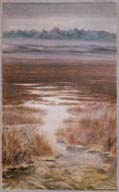 |
|
Dol Amroth: City of Gondor and once a haven of the Elves, Dol Amroth is the
main city of the Belfalas region. At the time of the War of the Ring,
it's leader, called the Prince of Dol Amroth was Imrahil.
|
|
|
Dunharrow: Originally built during the Dark Years, by the men who were to
become the "Dead Men of Dunharrow", Dunharrow was afterwards used
as a stronghold and refuge during times of war by both Gondor and
later Rohan. It is located in the Ered Nimrais, the White Mountains.
|
|
|
Dale: A town to the immediate south of the Lonely Mountain, Dale was
ruined by Smaug. After the death of Smaug and the Battle of the
Five Armies, Dale was eventually rebuilt under the kingship of Bard.
In the time of the War of the Ring, Dale's king was Brand, who fell
soon before the end of the Ring.
|
|
|
Druadan Forest: One of the few remaining places where the Druedain, survived at
the time of the War of the Ring, though they were hunted as beasts,
though King Théoden made a promise to one of the headmen, Ghan-buri-ghan,
that they would no longer do so.
|
|
Dol Guldur: The second stronghold of Sauron. Dol Guldur was located in Mirkwood
and was the probable reason that the forests name was changed from
Greenwood the Great. The fortress was probably built between the
years of 1000 and 1100 of the Third Age. During the War of the Ring
the fortress was home to one of the Nazgûl. It was completely
destroyed by the forces of Lothlorien after the end of the War of
the Ring.
|
|
|
Doriath: The realm of Thingol in Beleriand, Doriath was one of the greatest
of the Elf-kingdoms. It was sacked by Dwarves after the death of
Thingol. After which Dior Eluchíl, his grandson became king. Dior
was slain by the sons of Fëanor and so ended the realm of Doriath.
Within Doriath was Mengroth, the underground palace.
|
|
| Back To The Top | |
|
Ered Luin: The Ered Luin are the Blue Mountains. During the First Age, this
mountain range was the eastern boundary of Beleriand. At the end
of the First Age, they were split by the gulf of Lhûn. There were
at least two dwarf-cities in the Blue Mountains during the First
Age, and at least one partially survived as it is said that Dwarves
still passed through the Shire on their way to their cities in the
Blue Mountains.
|
|
The Eastfarthing: The easternmost section of the original Shire. The eastern border
of the Eastfarthing was the Brandywine River. Later, the region of
Buckland, across the Brandywine River was added to the Shire.
|
|
|
Ered Lithui: The Ash Mountains on the northern border of Mordor.
|
|
|
Ephel Dúath: The Mountains of Shadow on Mordor's western border. The only known
pass through this range is Cirith Ungol, the Spider Pass, also known
as the Morgul Pass.
|
|
|
Esgaroth: Often called Lake-Town, Esgaroth was built on posts driven into
the Long Lake. The original town was destroyed when Smaug fell upon
it in his death. It was later rebuilt somewhat to the north of the
original site. The posts and the body could be seen much later,
untouched.
|
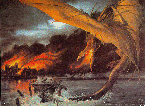 |
|
Edoras: The capital city of Rohan. Edoras apparently had a dike, wall and
thorny fence surrounding it: |
|
|
The Emyn Muil: A region of fairly barren cliffs on each side of the Anduin River. At the base of the cliffs were often bogs and fens: We can't get down, and if we did get down, we'd find all that green land a nasty bog, I'll warrant. (LOTR.627) In earlier days the Emyn Muil were covered with trees, though they
were gnarled and stunted, though by the time of the War of the Ring,
few trees still lived. |
 |
|
Erebor: The Lonely Mountain. Erebor was first settled just after Moria
was deserted, and later attracted the attention of Smaug, who until
the Quest to destroy Smaug was successful in the year 2941 of the
Third Age. After this Erebor thrived and continued to grow. There
is no record of what end it finally came to, if any, Erebor may
still be in existence.
|
|
|
Eregion: During the Second Age of the Sun, Eregion, which was nigh to the
West-Gate of Moria, was settled by the Elven-Smiths. It was ruined
and abandoned in the year 1697 of the Second Age, during their war
with Sauron.
|
|
| Back To The Top | |
|
Fornost Erain: The capital of Arnor after Annúminas, Fornost was once captured
by the forces of Angmar. Though retaken, it was abandoned as in
that same year came the end of the North Kingdom as such. After
abandonment, Fornost Erain was known as Deadmans Dike.
|
|
|
Fangorn Forest: The eastern remnant of the forests covering Middle-Earth in the
Elder Days, Fangorn forest, and possibly the Old Forest, were the
only remains of the forests of the Elder Days. Fangorn Forest was
certainly the only one with the Shepherds of the Trees still surviving.
Also called the Entwood, in Rohan, because of the Ents, who were
the Shepherds of the Trees. Fangorn Forest was an obviously old
forest, where there were some places that the original darkness
still had not been lifted according to Treebeard.
|
 |
|
Firien Wood: The wood surrounding the Halfirien, which was also known as Amon
Anwar, the Hill of Awe.
|
|
| Back To The Top | |
|
Gondor: The South Kingdom, Gondor was founded in the year 3320 of the Second
Age, by Elendil and his two sons ruled it until the War of the Last
Alliance, when Elendil and Anárion were killed. Then Isildur became
the High King of both kingdoms. The Kingship lasted until the year
2050 of the Third Age, when the last King died. After this the Stewards
ruled in the name of the King, until the year 3019, when Aragorn
took back the Kingship of both Arnor and Gondor. Related Entries: Númenor | Arnor | Osgiliath | Minas Anor | Rohan | Minas Tirith | Minas Ithil | Mordor | Minas Morgul | Elendil | Gil-Galad | Anárion | Isildur | Boromir | Faramir | Aragorn | Denethor II | Peregrin Took | The Witch-King | Sauron | Gandalf the Grey | Gandalf the White | Saruman | Palantiri | The One Ring | Isengard | The Gates of Argonath | The Anduin River | The Second Age of the Sun | The Third Age of the Sun | The Fourth Age of the Sun | The Quest of Mount Doom | The War of the Ring | The Battle of the Pelennor Fields | The War of the Last Alliance | The Kinstrife | The Siege of Barad-Dûr | The Great Plague |
|
The Golden Wood: Another name for Lothlórien.
|
|
The Glittering Caves of Aglarond: This was the cave complex at Helm's Deep. During the Battle of Helm's Deep, Gimli was one of those who took refuge within the caves when the wall was breeched. When he saw the beauty of the natural caves, he resolved to bring his kin-folk to see them as well, calling them a marvel of the known world. Gimli was so eloquent about the caves that Legolas found himself lost for words. After the War of the Ring, Gimli became the Lord of the Glittering
Caves.
|
|
Gondolin: The hidden city built by Turgon, Gondolin was the longest lasting
of the Elven realms in Beleriand. It was built in the hidden valley
of Tumladen within the Echorath. There was only one easy entrance,
known as the "Way of Escape". The city was designed in
memory of the city of Túna, and after time, equaled it. |
 |
The reason that Gondolin survived so long in the wars against Morgoth was that for many years nobody knew where it was. Only four people came into the city later than those who founded it. Those four were Maeglin, Eöl, Hurín and Huor. Also, Ulmo had long blessed the waters of the Sirion River. Turgon took ten thousand of his forces to the Nirnaeth Arnoediad, revealing the existence of the city for the first time. However, the secret of the city's location remained. After the battle, Tuor was brought to Gondolin. Later Earendil was born to Idril. The city was eventually betrayed by Maeglin, who had been captured
by Morgoth. The forces sent against Gondolin included: wolves,
orcs, dragons and Balrogs. The destruction was utter and complete.
|
 |
|
The Grey Havens: A coastal town in the Gulf of Lhûn. This was Círdan's residence from the beginning of the Second Age of the Sun until some point in the Fourth Age, when he too took ship into the West. By some time in the Third Age, this was the point from which the vast majority of the Eldar left Middle-Earth via the Straight Road. Apparently, many had at one point left from a location near or within Gondor at some point, but by the time of the War of the Ring, unless the elf wanted to construct his own ship, the Grey Havens were their only port. Another name for the Grey Havens was Mithlond.
|
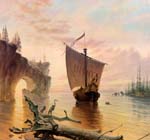 |
| Back To The Top | |
|
The Hornburg: A Fortress in Rohan, probably built by the Men of Gondor, the
Hornburg was a refuge in times of war. Untill the War of the Ring,
the Hornburg had never yet fallen to an enemy, and it did not
even then, though it was a close call, and only due to the Huorns
and the Men of Erkenbrand. I do not know if it ever fell after
the War of the Ring, though I think not.
|
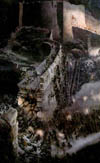 |
Helm's Deep: The region surrounding the fortress of the Hornburg. The Glittering
Caves of Aglarond were a part of the defensive complex that made
up Helm's Deep.
|
|
The Houses of Healing: Located in Minas Tirith, the Houses of Healing were in the sixth
circle, on the southern side. This is where Merry, Faramir and Éowyn
were cured from their encounters with the Witch-King.
|
|
Henneth Annûn: One of the hidden refuges built by the Rangers of Ithilien after
the region became the target of raids and troop movements by Sauron.
This is where Frodo and Sam stayed the night after meeting Faramir.
The most spectacular feature of the caves was that the setting
sun and the moon could shine through the waterfall in such a way
as to produce spectacular effects. It was sometimes called the "Window
on the Sunset". |
|
|
Hobbiton: A town in the Shire, Hobbiton was the location of Bag-End.
|
|
| Back To The Top | |
|
Isengard: Another fortress in Rohan, built by the Númenoreans, Isengard was
extremely defendable, and the key to the defense of Rohan, as was
discovered in the time of Helm Hammerhand, much to their dismay.
It was always part of Gondor, even when Eorl was given the land
surrounding it. Isengard was given to Saruman in the year 2759 of
the Third Age, by the Steward Beren. Isengard was at least partially
destroyed by the Ents in the year 3018 of the Third Age. In the
language of Rohan, Isengard was Angrenost.
|
|
|
Ithilien: Ithilien was once a beautiful area of Gondor, often called the
Garden of Gondor, though it was eventually abandoned after the taking
of Minas Ithil. Ithilien was located between Minas Ithil and the
Anduin. Even in the years of the War of the Ring, the hobbits could
see the remaining beauty of Ithilien, though it was no longer tended
and had fallen into ruin. After the War of the Ring, Ithilien was
given to Faramir, by the King Elessar.
|
|
| Back To The Top | |
| Back To The Top | |
|
Khazad-dûm: The home of Durin, the eldest of the Seven Fathers of the Dwarves, Khazad-dûm was the greatest of the Dwarven mansions, especially after the destruction of Beleriand which partially destroyed Nogrod and Belegost. Many dwarves fled from Nogrod and Belegost to Khazad-dûm, swelling its population. Khazad-dûm was the only place where mithril could be found, but mithril was also the cause of their destruction, as in mining for mithril, they accidentally freed the Balrog. The Dwarves abandoned Khazad-dûm in the year 1981 of the Third Age. After the Dwarves left, Sauron sent orcs to gather all the mithril, gold and jewels that could be found. The Elves called Khazad-dûm Moria, the Black Chasm afterwards. It was in Moria that Gandalf fell fighting the Balrog. There was a prophecy that one day the Dwarves would retake Moria, referred to in the following: Related Entries: Eregion | Gandalf the White | Balin | Gandalf the Grey | The Second Age of the Sun | The Third Age of the Sun |
|
| Back To The Top | |
Lothlórien: The realm of Galadriel and Celeborn, Lothlórien, known as Lórien by the end of the Third Age consisted of the region between the Anduin River and the Celebrant. Galadriel protected her home with the Elven Ring Nenya. Other names for Lothlórien included the Golden Wood, Laurelindórinan, and the Hidden Land. The majority of the Elves living in Lothlorien were of Silvan descent.
|
|
| Back To The Top | |
|
Minas Anor: Minas Anor, the city of Anárion.The name translates to The Tower
of the Setting Sun. One of the three main cities of Gondor, Minas
Anor was renamed Minas Tirith, the Tower of Guard after Minas Ithil
was taken by the Nazgûl. It became the capital city after Osgiliath
had started to be abandoned in the year 1640 of the Third Age.
|
 |
Minas Tirith: At first called Minas Anor, this city was renamed Minas Tirith, the Tower of the Guard after Minas Ithil was taken by the Nazgul in the year 2002 of the Third Age of the Sun. It later became the capital city of Gondor after Osgiliath was abandoned, and remained the major city in Gondor until the War of the Ring. In structure, the city was built of white stone in seven levels going back into the side of Mount Mindolluin. The entire structure of the city is geared towards it's defense. The gates of Minas Tirith were destroyed during the Battle of the
Pelennor Fields, and the first circle of the city was pretty much
destroyed by fire during the preceeding siege. After the War of the
Ring, Aragorn made Minas Tirith into his capital city in Gondor.
|
|
|
Minas Ithil: The twin city to Minas Anor, Minas Ithil was the city of Isildur
and its name translates as The Tower of the Rising Moon, often just
called The Tower of the Moon. It was taken by the Nazgûl in the
year 2000 of the Third Age and renamed, in Gondor, Minas Morgul,
the Tower of Black Magic. It was a terrible place until the fall
of Sauron, and judged by the King Elessar not fit to live near for
long years after the War of the Ring.
|
|
|
Mordor: Mordor, translated as, the Black Land, was the realm of Sauron,
and where he forged the One Ring. This was Sauron's home from
around the year 1000 of the Second Age, to the year 3019 of the
Third Age, when Frodo destroyed the One Ring in Mount Doom.
However, there were intervals where he resided elsewhere, such as the time
between the War of the Last Alliance and the Quest of Erebor. In
those years, Sauron first was regaining shape, and then in residence
in the forest of Mirkwood. |
|
|
Moragai: The Moragai was the inner fence of Mordor, on the east. Lower than
the Ephel Dúath, the Moragai was not entirely barren, with thorny
bushes, harsh grasses and biting flies.
|
|
|
Mathom House: A museum in the Shire, the Mathom House was located in Michel Delving.
Before Bilbo left the Shire, he had loaned his mithril coat to the
Mathom House to display.
|
|
|
Mengroth: The home of Elu Thingol in Beleriand, Mengroth was built underground,
like the stronghold of the Elves of Mirkwood. Mengroth was destroyed
in the sack of Doriath.
|
|
|
Meneltarma: The Meneltarma was the mountain at the centre of Númenor, used
as a temple to Eru, left untouched by Men, Later, when Númenor sank
beneath The Wave, it was said the top of Meneltarma remained an
Island, but it was never found. Four times a year, in the appropriate
times, the King led a procession to the top. This continued until
the times of the King's Men, when the hallow was neglected.
|
|
|
Mere of Dead Faces: The Mere of Dead Faces in the Dead Marshes was a horrible place,
especially at night, which was when Frodo, Sam and Gollum passed
through. This description fits the entire Dead Marshes, but goes with the
painting on the right, which is of the Mere of Dead Faces. |
 |
|
Minas Morgul: Once, Minas Ithil, but was taken by Sauron and made into a place
of horror: After the War of the Ring, Minas Morgul and Imlad Morgul were destroyed,
though the valley was not safe to live in for many years after.
|
|
|
Misty Mountains: But the mountains were the Hithaeglir, the
Towers of Mist upon the borders of Eriador; yet they were taller
and more terrible in those days, and were reared by Melkor to hinder
the riding of Oromë. (S.62-63) |
 |
|
Mirkwood: Originally named Greenwood the Great, and later after the War of
the Ring, named Eryn Lasgalen, or the Wood of Green Leaves, once
Sauron built his fortress, Dol Guldur there, the name became Mirkwood.
During this time period, the forest was very dark and gloomy. According to Bilbo, in the regions of the road, the spiderwebs
were huge, there were no safe sources of water, the nights were
full of eyes and the animals, what few there were, were almost inedible.
On top of this, there were giant spiders in some area, although,
apparently the Wood-elves tried to keep them away from their realm.
|
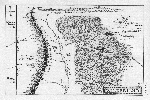 |
| Back To The Top | |
|
Númenor: The island given as a gift to the Edain at the end of the First Age of the Sun. It was given as a reward for their fight against Morgoth. Númenor was nearer to the Undying Lands than to Middle-Earth. Nevertheless, the Men of Númenor were not permitted to sail to either Tol Eressëa or the Undying Lands. Instead they became great mariners and explored Middle-Earth. The Island of Númenor was in the form of a star with five arms, as can be seen in the picture to the right. A clearer view is given of the fragments of books remaining that have been gathered into the Unfinished Tales, for there is a map of Númenor as well as several tales surviving from the Third Age. Near the end of the Second Age of the Sun Númenor was destroyed as told in the Alkallabêth. Only nine ships survived this disaster and of them came the realms of Arnor and Gondor, the realms in Exile. Other names for Númenor include: Related Entries: Morgoth | Sauron | Elrond | Elros | Eärendil | Elendil | Isildur | Anárion | Gondor | Arnor | Meneltarma | Aman | Tol Eressëa | Valinor | Palantiri | Dúnedain | The Second Age of the Sun |
 |
The Northfarthing: The northernmost of the four central regions of the Shire. The Northfarthing
was known for it's hunting and for barley. This was also the only
region in the Shire where snow was common.
|
|
|
Narogthrond: The home of Finrod Felagund, Narogthrond was nigh to the river
Narog in the First age of the Sun. It was destroyed by the dragon
Glaurung.
|
|
|
A region in Beleriand on the coast.
|
|
| Back To The Top | |
|
Osgiliath: The first capital city of Gondor, Osgiliath was decimated in the Plague, then the capital was moved to Minas Anor in the year 1640 of the Third Age. Osgiliath was abandoned by the time of the War of the Ring, and the bridge was destroyed in the year 3017-3018 as was told by Boromir at the Council of Elrond. At it's founding, Osgiliath was the site for the chief of the
palantíri
that Elendil brought to MIddle-Earth. It was lost during the Kin-strife
between 1432 and 1448 of the Third Age. |
 |
The Old Forest: The forest on the eastern borders of Buckland. On it's eastern edge was the Barrow-Downs. It was a frightening place where few hobbits would enter. According to Fangorn, the Old Forest was one of the remaning fragments of the original forests that covered Western Middle-Earth, as was Fangorn Forest. It is recorded in the Red Book that the trees were known to move at times, and were actually threatening to the Hobbits, as Merry, Pippin, Frodo and Sam found on their journey. It is likely that a large number of the trees were Huorns, such as Old Man Willow. Tom Bombadil and his wife Goldberry lived in the Old Forest on the
banks of the Withywindle.
|
|
Orodruin: The volcanic mountain within the land of Mordor, this is the location where Sauron forged the One Ring. The name translates as Mount Doom. As the place where the One Ring was forged, the Cracks of Doom within the mountain are the only place where the Ring could be destroyed. Orodruin was an active volcano through the Second and Third Ages
in the periods when Sauron was a strong force in Middle-Earth and
in residence in Mordor. Sauron clearly had some form of control over
the activity of the mountain, as it was used as a weapon during the
War of the Ring, when the smoke blocked the light from a large part
of western Middle-Earth.
|
|
|
Orthanc: The tower and city within the ring of Isengard. Orthanc was first
built by the Men of Gondor. Though the land surrounding was given
to the Rohirrim, Isengard was retained by the Stewards of Gondor.
In the time of the Steward Beren, the Keys of Orthanc were given
to Saruman. At the end of the Third Age of the Sun, Sauruman had
changed Orthanc and Isegard to a mockery of Barad-Dûr. Orthanc survived
the attack of the Ents in the year 3018 and was given back to the
King of the Reunited Kingdom, Aragorn. This was the site of one
of the four palantíri until the year 3018 of the Third Age.
|
|
| Back To The Top | |
|
Pelargir: A harbour on the mouths of the Anduin river, this was the location
of the King's fleet and also subject to attacks by the Corsairs
of Umbar.
|
|
|
Parth Galen: The lawn where the Company of the Ring camped above the Falls of
Rauros before the Company was broken.
|
|
The Prancing Pony: The Inn at Bree where Frodo, Sam, Merry and Pippin stayed the night. The Prancing Pony was owned by Barliman Butterbur. |
|
The Paths of the Dead: These were the passages under the Ered Nimrais (White Mountains) between Dunharrow and the Morthond Vale. At the time of the War of the Ring at the end of the Third Age, the Paths of the Dead were a place of fear and dread as none had returned after entering. At least one of the paths lead straight through the mountains, though there were doors and paths branching off it as well. Presumably, some of the passages might have been either a stronghold, safe from attacks, similar to Helm's Deep or perhaps the homes of the Men living there at the time of the War of the Last Alliance. Certainly the Dead haunting them were the spirits of those Isildur cursed. It was said that only an heir of Isildur could safely pass the Paths of the Dead, which Aragorn did during the War of the Ring, along with Legolas, Gimli and the Rangers of the North. It is likely that once the Dead had fulfiled their oath, the Paths became
safe again, though doubtful that many ever used the passages again due to the
memory of the danger. |
|
| Back To The Top | |
| Back To The Top | |
|
Rauros: The Falls of Rauros are in the North-West of Gondor. Located on
the Anduin River, the Falls of Rauros are preceded by the Argonath,
the Gates of the Kings. The Company of the Ring sent Boromir's body
over the Falls as they did not have the time to do anything else such
as bury him.
|
|
|
Rohan: Also known as the Mark and the Riddermark, Rohan was formerly
a part of Gondor, known as the plains of Calhenardon. It was ceded
to Eorl by Cirion, then the Steward of Gondor. The Men of Rohan
are famed horsemen and their horses are justly famous too. At
the time of the War of the Ring, Rohan was beset on the West as
well as on the East. For on the West was Saruman, and to the East,
their allies, Gondor was fighting the Hosts of Sauron. They were
victorious in the west, and arrived in time to make a difference
in the Battle of the Pelennor Fields. |
 |
The Riddermark: Another name for Rohan. |
|
Rivendell: Known as Imladris and the Last Homely House, Rivendell was the home of Elrond Halfelven. Rivendell was founded in the Second Age of the Sun and lasted until some time in the Fourth Age, though Elrond sailed into the West at the end of the Third Age. Most of the Chieftains of the Dunedain, were fostered there, as was Aragorn in his youth. It was located on the Bruinen. Bilbo, during the Quest of Erebor spent some time in Rivendell, and later left the Shire to live there after his eleventy-first birthday. Frodo stopped in Rivendell for a time on both the trip to Mordor, and his return to the Shire. Bilbo described Rivendell as "His house was
perfect whether you liked food, or sleep, or work, or story-telling,
or singing, or just sitting and thinking best, or a pleasant mixture
of them all. Evil things did not come into that valley." (H.58) |
 |
Rhudar One of the three regions that Arnor was divided into in the year 861 of the Third Age at the death of King Eärendur. The other two regions were Arthedain and Cardolan. The kingdom of Rhudar included the land between the Ettenmoors and the Weather Hills. South, it extended to the Misty Mountains. Rhudar had few folk of Dúnedain descent, the majority of those living in the country were Hill-men, who, it was later discovered were in league with the forces of Angmar, lead by the Witch-King. They were in complete control of the country by the year 1375 of the Third Age. Between 1375 and 1975 of the Third Age, when Rhudar finally fell with
the defeat of the Witch-King, they fought against the Dunedain of Arthedain
and Cardolan. However, Cardolan fell within a few decades, in the year
1409. |
|
| Back To The Top | |
|
Sarn Ford: A ford to the south of the Shire.
|
|
|
Sarn Gebir: A dangerous area of rapids in the Anduin River. Sarn Gebir was
near the Gates of Argonath and the Emyn Muil. There was a path around
the rapids surviving into the War of the Ring.
|
|
|
Sirion River: A river in Beleriand, the Sirion was over 130 leagues long from
springs to mouth.
|
|
|
Sammath Naur: The Chambers of Fire, within Orodruin. This was where Sauron forged
the One Ring and where at the end of the War of the Ring, the Ring
was destroyed.
|
|
|
Southfarthing: One of the five regions of the Shire at the time of the War
of the Ring. The other areas were the Northfarthing, Westfarthing, the Eastfarthing and Buckland This is the
southernmost area of the Shire. The Tower Hills were added by
the decree of the King sometime in the early Fourth Age.
|
|
The Shire: Located in the North-West of Middle-Earth, this is the country of the Hobbits. It was ceded to them by Argleb II in the year 1601 of the Third Age of the Sun. Originally consisting of four areas that they called Farthings, which were the Northfarthing, Westfarthing, Southfarthing and Eastfarthing. Later the area of Buckland was added to the Shire. By the decree of King Elessar, early in the Fourth Age of the Sun, the Westmarch, including the Tower Hills was added to the Shire. By the decree of the King, no Men were to enter the Shire at all. Only two battles were ever fought in the Shire: The Battle of Greenfields, fought against orcs, in 2747 and the Battle of Bywater at the end of the War of the Ring in 3019. Many areas of the Shire are named for families prominent in that region, such as the Tookland or Buckland. However, other than in those two cases, where the families still lived mostly in that region, hobbit families had spread to the rest of the Shire. |
 |
| Back To The Top | |
| Tol Brandir: An island in the Anduin River. Its sides are so steep that no Man,
Dwarf or Elf has ever set foot on it. It is between Amon Hen and
Amon Lhaw.
|
|
|
Tol Eressëa: The Lonely Isle. A part of the Undying Lands, this island was removed
from the Circles of the World along with Aman in the Downfall of
Númenor. It can still be reached by the ships of the Elves along
the Straight Road.
|
|
|
The Towers of the Teeth: Two towers built by the Men of Gondor after the War of the Last
Alliance to prevent evil from entering into Mordor again. They were
taken by Sauron and used to defend against invaders in the Morranon.
|
|
The Tookland: The Tookland was one of the folklands of the Shire. Historically, it would have been populated by the Took Family, and most of that family still lived in that region. The Tookland was located in the Green Hill region of the West Farthing area. |
|
| Back To The Top | |
|
Udûn: The plain within the Isenmouthe.
|
|
|
Umbar: The northernmost realm of Harad. During the reign of the Kings of Gondor, Umbar acknowledged the sway of Gondor. In the Second Age of the Sun, Umbar was a haven for the Númenorean ships. The defeated rebels from the Kinslaying in the Third Age of the Sun fled to Umbar, whence came the Corsairs which were such a curse to Gondor until the end of the War of the Ring. The fleet sent to war against Sauron from Númenor conquered him
at Umbar. There was set a giant crystal in memorial. However, when
Sauron returned, this symbol of his humiliation was thrown down.
|
|
|
Undying Lands: Aman and Tol Eressëa, the lands of the Valar and the Lonely Isle.
The lands removed from the Circles of the World at the time of the
Downfall of Númenor.
|
|
| Back To The Top | |
|
Valinor: The Land of the Valar.
|
|
|
Valimar: The city of the Valar, the main city of Valinor. Not all of the
Valar live there.
|
|
| Back To The Top | |
|
Westfold: The western regions of Rohan.
|
|
|
Weathertop: An outpost of Arnor, there was the tower of Amon Sûl until it was
destroyed. This was where Frodo, Sam, Merry, Pippin and Strider
were attacked by the Black Riders and Frodo was wounded.
|
|
The Westfarthing: One of the four farthings making up the Shire. The Westfarthing is where Hobbiton,
Bywater and Michel Delving were located.
|
|
| Back To The Top | |
| Back To The Top | |
| Back To The Top | |
|
Zirak-Zigil: One of the mountains over the Mines of Moria, also called the Silvertine
and Celebdil.
|
|
| Back To The Top | |
|
Books used in this document:
|
|
| Entries to be Added | |
| This page was last modified on . |

